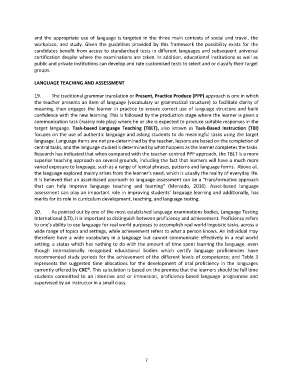Page 1480 - SUBSEC October 2017_Neat
P. 1480
and the appropriate use of language is targeted in the three main contexts of social and travel, the
workplace, and study. Given the guidelines provided by this framework the possibility exists for the
candidates benefit from access to standardised tests in different languages and subsequent universal
certification despite where the examinations are taken. In addition, educational institutions as well as
public and private institutions can develop and rate customised tests to select and or classify their target
groups.
LANGUAGE TEACHING AND ASSESSMENT
19. The traditional grammar translation or Present, Practice Produce (PPP) approach is one in which
the teacher presents an item of language (vocabulary or grammatical structure) to facilitate clarity of
meaning, then engages the learner in practice to ensure correct use of language structure and build
confidence with the new learning. This is followed by the production stage where the learner is given a
communication task (mainly role play) where he or she is expected to produce suitable responses in the
target language. Task-based Language Teaching (TBLT), also known as Task-Based Instruction (TBI)
focuses on the use of authentic language and asking students to do meaningful tasks using the target
language. Language items are not pre-determined by the teacher, lessons are based on the completion of
central tasks, and the language studied is determined by what happens as the learner completes the tasks.
Research has indicated that when compared with the teacher-centred PPP approach, the TBLT is a more
superior teaching approach on several grounds, including the fact that learners will have a much more
varied exposure to language, such as a range of lexical phrases, patterns and language forms. Above all,
the language explored mainly arises from the learner’s need, which is usually the reality of everyday life.
It is believed that an asset-based approach to language assessment can be a “transformative approach
that can help improve language teaching and learning” (Meniado, 2016). Asset-based language
assessment can play an important role in improving students’ language learning and additionally, has
merits for its role in curriculum development, teaching, and language testing.
20. As pointed out by one of the most established language examinations bodies, Language Testing
International (LTI), it is important to distinguish between proficiency and achievement. Proficiency refers
to one’s ability to use language for real world purposes to accomplish real world linguistic tasks, across a
wide range of topics and settings, while achievement refers to what a person knows. An individual may
therefore have a wide vocabulary in a language but cannot communicate effectively in a real world
setting, a status which has nothing to do with the amount of time spent learning the language, even
though internationally recognised educational bodies which certify language proficiencies have
recommended study periods for the achievement of the different levels of competence; and Table 3
represents the suggested time allocations for the development of oral proficiency in the languages
currently offered by CXC®. This calculation is based on the premise that the learners should be full time
students committed to an intensive and or immersion, proficiency-based language programme and
supervised by an instructor in a small class.
7

